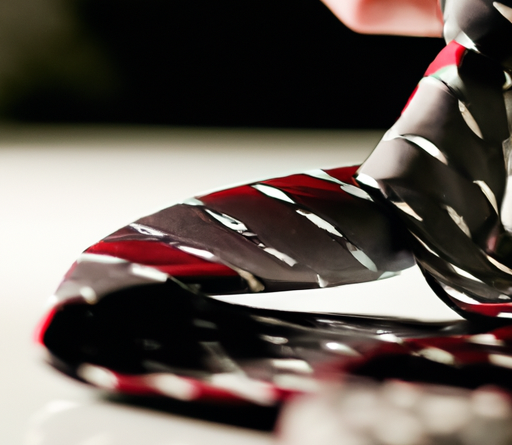
In this article, we will guide you through the process of learning how to tie a tie. We will provide step-by-step instructions and helpful tips to make it easier for beginners. Whether you’re getting ready for a formal event or simply want to add a touch of sophistication to your everyday outfit, you’ll learn the essential techniques to master this skill. So, grab your favorite tie and let’s get started on this fashion journey together!
Table of Contents
How to Tie a Tie for Beginners
Choosing the Right Tie
Selecting the Right Color
When it comes to choosing the right tie, selecting the right color is essential. The color of your tie should complement the color of your shirt and suit. It’s important to consider your overall outfit and the occasion you are dressing for. For a formal event, a classic solid color tie, such as black or navy, is a safe choice. If you want to add some personality, you can opt for a patterned tie in colors that coordinate with your outfit. Remember, the color of your tie should enhance your overall look and not distract from it.
Deciding on the Right Length
The length of your tie is another important factor to consider. The tip of your tie should ideally rest right at or slightly above your belt buckle. A tie that is too short can give off an unprofessional appearance, while a tie that is too long can look sloppy. If you are unsure about the length, it’s always better to go a bit longer rather than shorter, as you can always adjust the length by tying a smaller knot. Investing in a tie that matches your height is also a good idea, as some brands offer ties in different lengths.
Preparing the Tie
Straightening the Tie
Before you start tying your tie, it’s important to straighten it out. Lay the tie on a flat surface and use your fingers to smooth out any wrinkles or folds. This will ensure a neat and polished look when you wear your tie. If you have a silk tie, be extra careful when straightening it, as silk is a delicate fabric that can easily get damaged. Take your time to smooth out the tie, paying attention to both the front and back.
Positioning the Tie
Once your tie is straightened, it’s time to position it. Start by placing the wide end of the tie on your right side, and the narrow end on your left side. The wide end should be longer than the narrow end, as this will be used to create the knot later on. Make sure that the narrow end of the tie is shorter than the wide end, as this will make it easier to tie the knot. Keep the tie loose and adjust the length as needed before proceeding to the next step.

Starting the Knot
Placing the Wider End Over the Narrow End
To start tying your tie, take the wider end and cross it over the narrow end. The wide end should be on top of the narrow end, forming an “X.” Hold the crossing point with your fingers to secure it in place. This is the basic starting point for most tie knots and will serve as the foundation for the rest of the tying process.
Crossing the Wide End Over the Narrow End
Once you have crossed the wide end over the narrow end, it’s time to bring the wide end back underneath. Take the wide end and pass it underneath the narrow end, and then bring it back up through the loop created by the “X.” Pull the wide end all the way through the loop, ensuring that it is pulled tightly. This step sets the stage for creating the first loop of your tie knot.
Making the First Loop
Looping the Wide End Behind the Narrow End
Now it’s time to create the first loop of your tie knot. Take the wide end and loop it behind the narrow end, bringing it from left to right. Make sure to keep the loop loose, as you will need to manipulate it in the next step. The wide end should now be positioned on your right side, while the narrow end remains on the left side.
Pulling the Wide End Up Through the Loop
To complete the first loop, take the wide end and pull it up through the loop from underneath. This will create a second loop around the narrow end. Hold onto the loop with your fingers to keep it in place, as you will need it for the next step. This is the halfway point of tying your tie knot and sets the foundation for the final steps.

Creating the Second Loop
Forming a Second Loop with the Wide End
To create the second loop of your tie knot, take the wide end and loop it around the front of the knot. Bring the wide end from right to left, forming a loop on top of the existing knot. The wide end should now be positioned on the left side of the knot, while the narrow end remains on the right side.
Pulling the Wide End Through the Second Loop
Now it’s time to pull the wide end through the second loop. Take the wide end and feed it through the loop from underneath, with the tip pointing towards your chest. Pull the wide end all the way through the loop, ensuring that it is pulled tightly. This step finalizes the second loop and completes the structure of your tie knot.
Tightening and Adjusting
Pulling the Knot Tight
Once you have completed the knot, it’s important to tighten it properly. Hold onto the narrow end of the tie with one hand, and use your other hand to pull the knot upwards. Gently pull the knot tight, making sure that it is snug but not too tight. Take your time to adjust the knot as needed until you are happy with the tightness.
Adjusting the Knot to Desired Tightness
If you find that the knot is too loose or too tight, you can easily adjust it. Simply hold onto the narrow end of the tie and gently push or pull the knot to your desired tightness. Take care not to mess up the structure of the knot while making adjustments. Remember, a properly tied and adjusted knot will give you a polished and professional look.
Finalizing the Knot
Flattening the Knot
To give your tie knot a smooth and flat appearance, gently pinch the sides of the knot with your fingers. Apply a slight pressure to flatten out any wrinkles or folds. Be careful not to squeeze too hard, as this may distort the shape of the knot. Take your time to work on all sides of the knot until it looks neat and symmetrical.
Tucking the Narrow End Behind the Loop
Once your knot is finalized, you can tuck the narrow end of the tie behind the loop. Take the narrow end and pass it behind the loop, bringing it from right to left. This step adds a finishing touch to your tie knot and prevents it from coming undone throughout the day. Make sure that the narrow end is securely tucked behind the loop, but still visible.
Alternative Tie Knots
Trying the Four-in-Hand Knot
If you feel confident in tying the basic knot and want to explore other options, the Four-in-Hand knot is a great alternative to try. It’s a simple and versatile knot that works well with most tie widths and collar styles. To tie the Four-in-Hand knot, follow the same steps for the basic knot but with a slight variation in how you form the loops. Experimenting with different knots can add variety to your tie collection and help you discover new styles that suit your personal taste.
Experimenting with the Pratt Knot
For a more symmetrical and formal look, the Pratt knot is a popular choice. It produces a medium-sized knot that is suitable for both wide and narrow collars. To tie the Pratt knot, follow the same initial steps for the basic knot, but with a different approach in forming the loops. The Pratt knot is often preferred for dressier events or professional settings. Just like with any knot, practice is key to mastering the Pratt knot and achieving a polished and sophisticated look.
Troubleshooting
Fixing a Crooked Knot
If you find that your tie knot is crooked or uneven, don’t worry. It’s a common issue that can easily be fixed. Gently loosen the knot and adjust it until it is straight and centered. Make sure to hold onto the narrow end of the tie while making adjustments to prevent the knot from coming undone. Take your time to straighten out the knot and ensure that it sits properly on your collar.
Reattempting a Failed Knot
If your first attempt at tying a knot doesn’t turn out as expected, don’t get discouraged. Tying a tie is a skill that takes practice. Simply untie the knot and start again from the beginning. Remember the steps and take your time to make sure each step is done correctly. With a bit of patience and practice, you will become more comfortable and proficient in tying a tie.
Conclusion
Mastering the art of tying a tie is a valuable skill that every gentleman should possess. It may seem daunting at first, but with practice and patience, you’ll be able to tie a perfect knot effortlessly. Remember to choose the right tie, prepare it properly, and follow the steps carefully. Experiment with different tie knots to add variety to your wardrobe. Don’t be discouraged if your first attempts are not perfect – practice makes perfect. Soon enough, you’ll be able to tie a tie with confidence and style, adding a touch of sophistication to any outfit.


